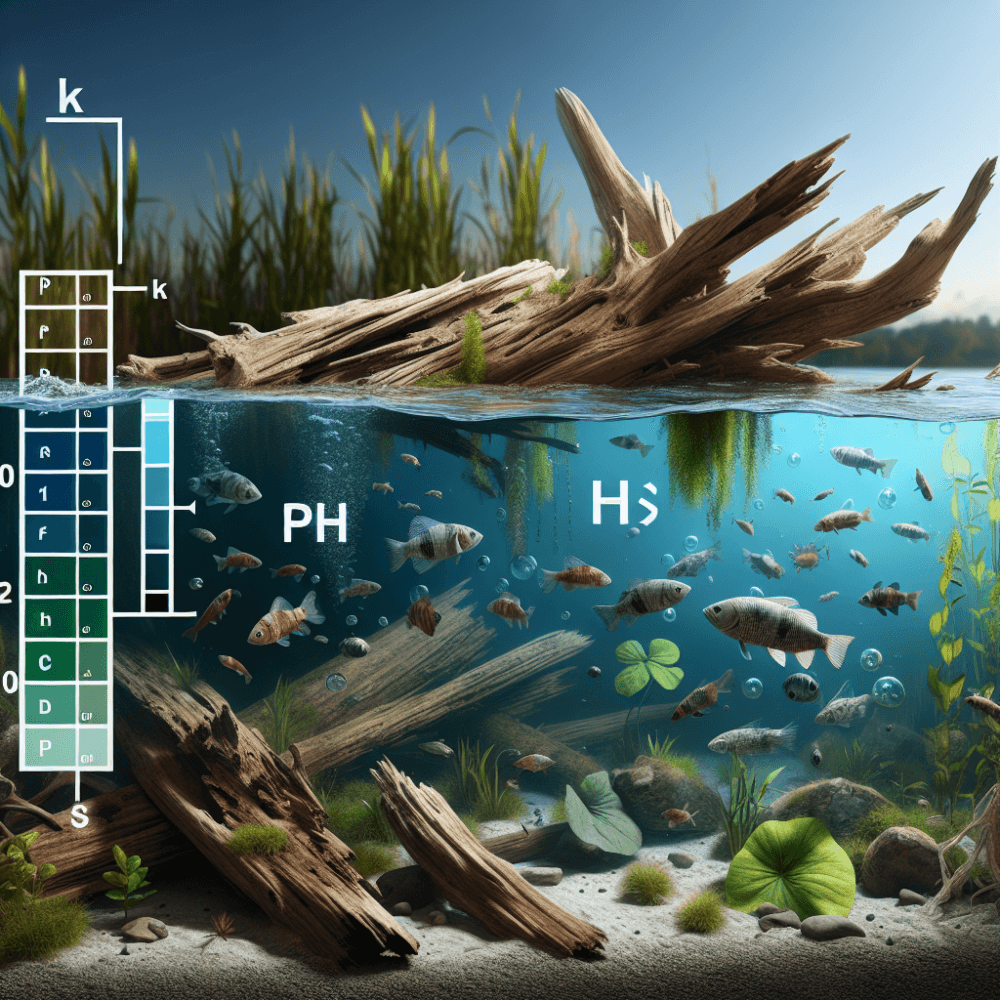Intriguingly, have you ever wondered if driftwood has the power to lower pH levels? This captivating article delves into the question, exploring the potential effects of driftwood on pH and its implications for aquatic environments. From unraveling the science behind pH levels to discussing the role of driftwood in natural habitats, this article offers a friendly and informative perspective on a fascinating phenomenon. So, let’s embark on this intriguing journey and uncover the secrets of driftwood and its impact on pH!

What is driftwood?
Definition of driftwood
Driftwood refers to the wood that has been washed ashore onto beaches, rivers, or lakes, typically after being carried by currents or winds. It is essentially pieces of wood, such as branches or logs, that have detached from trees and have been transported by water. Driftwood can vary in size, ranging from small twigs to large logs, and can be found in various stages of decay. It is commonly found along coastal areas but can also be present in inland bodies of water.
Characteristics of driftwood
Driftwood possesses unique characteristics that distinguish it from regular wood. Due to its exposure to water, driftwood is often weathered, giving it a distinct appearance. The constant motion of the water can smooth the edges of the wood and etch intricate patterns onto its surface. Additionally, driftwood may appear bleached due to prolonged exposure to sun, saltwater, or freshwater. The exact appearance of driftwood depends on various factors such as the type of wood, length of time spent in the water, and the specific environmental conditions it has been subjected to.
The role of pH in aquatic environments
Understanding pH
pH is a measure of the acidity or alkalinity of a substance, and it plays a crucial role in aquatic ecosystems. It is a logarithmic scale ranging from 0 to 14, with 7 being considered neutral. A pH value below 7 indicates acidity, while a value above 7 indicates alkalinity. The pH level of water affects various biological and chemical processes, including nutrient availability, chemical reactions, and the overall health of aquatic organisms.
Implications of pH in aquatic ecosystems
The pH level of an aquatic environment can significantly impact the organisms living within it. Most aquatic organisms have specific pH requirements for survival and reproduction. Extreme or rapid changes in pH can lead to stress or even death for sensitive species. Additionally, pH influences the solubility and availability of nutrients and minerals in water. For example, certain nutrients may become less accessible to plants or algae if the pH is outside their optimal range. Consequently, the imbalances in pH can disrupt the delicate equilibrium of aquatic ecosystems.
Factors affecting pH
Natural sources of pH variation
Several natural factors contribute to the variation in pH levels in aquatic environments. Geological characteristics, such as the presence of limestone or volcanic rocks, can influence the pH of water bodies. Decaying organic matter, such as leaves and algae, can also release acids or bases into the water, affecting its pH. Additionally, rainwater can have a lower pH due to dissolved carbon dioxide, causing a decrease in pH when it mixes with other water bodies.
Human-induced factors influencing pH
Human activities can have a significant impact on the pH levels of aquatic environments. Pollutants such as acid rain, industrial discharge, and agricultural runoff can introduce harmful substances into water bodies, altering their pH. Chemical fertilizers and pesticides used in agriculture can also contribute to pH changes in nearby water sources. Furthermore, the construction of dams or the diversion of water can disrupt natural flow patterns, potentially affecting pH levels in connected ecosystems.
Driftwood and pH
The acidity of driftwood
Driftwood, especially when freshly submerged, can release tannins and organic acids into the surrounding water. These substances can contribute to a decrease in pH, making the water more acidic. The acidity of driftwood can vary depending on factors such as the type of wood, age of the wood, and the duration it has been submerged in water.
Alkalinity and driftwood
While driftwood may initially lower the pH of the water, it can also contribute to the overall alkalinity of the aquatic environment. As the wood decays over time, it releases various compounds, including alkaline minerals, into the water. These minerals can act as buffering agents, helping to stabilize the pH and prevent drastic fluctuations. The extent to which driftwood affects alkalinity depends on several factors, such as the composition of the wood and the surrounding water chemistry.

Effects of driftwood on pH levels
pH decrease due to driftwood
When submerged in water, driftwood can release tannins and organic acids, which can lead to a decrease in pH levels. This decrease in pH can have implications for aquatic organisms that have specific pH requirements for survival. Some species may be adversely affected by the acidic conditions created by the presence of certain types of driftwood.
pH increase due to driftwood
Although the initial effect of driftwood on pH is generally a decrease, the long-term decomposition of driftwood can contribute to an increase in pH levels. As the wood decomposes, it releases alkaline minerals into the water, effectively raising the pH. This increase in pH may affect different species in the ecosystem, particularly those that are sensitive to alkaline conditions.
Driftwood as a pH buffer
Buffering capacity of driftwood
Driftwood serves as a natural pH buffer in aquatic environments. By releasing tannins, organic acids, and alkaline minerals, driftwood can help stabilize pH levels and prevent extreme fluctuations. The buffering capacity of driftwood depends on various factors, including the type of wood, the quantity of driftwood present, and the water’s alkalinity and hardness levels.
How driftwood affects pH stability
The presence of driftwood can enhance pH stability by counteracting changes caused by other factors. In areas with naturally low pH, driftwood can contribute to increased alkalinity, helping to raise pH levels and create a more favorable environment for certain species. Similarly, in areas with high pH, driftwood’s acidic properties can help neutralize the water and stabilize pH. The complex interactions between driftwood and water chemistry can ultimately contribute to the overall stability of pH in aquatic ecosystems.
Interactions between driftwood and other components
Driftwood and water hardness
Water hardness refers to the concentration of minerals, usually calcium and magnesium, present in the water. Driftwood can interact with these minerals, particularly calcium, and contribute to water hardness. As the wood decomposes, it releases calcium ions, increasing the hardness of the water. This interaction can have implications for aquatic organisms that have specific hardness requirements for their survival and development.
Driftwood and nutrient levels
Driftwood, particularly when submerged for extended periods, can act as a source of nutrients in aquatic environments. During decomposition, the wood releases organic matter, which serves as a food source for microorganisms. These microorganisms, in turn, contribute to the nutrient cycle by breaking down the organic material and releasing nutrients such as nitrogen and phosphorus. The availability of these nutrients can influence the growth and productivity of various aquatic plants and algae.
Driftwood and beneficial bacteria
Driftwood provides a suitable substrate for the colonization of beneficial bacteria in aquatic environments. These bacteria play a crucial role in maintaining water quality by breaking down organic matter, removing harmful compounds, and helping to stabilize pH. The intricate structure and porous nature of driftwood provide a habitat for bacteria to inhabit and thrive. The presence of beneficial bacteria can enhance the overall health and balance of the aquatic ecosystem.
Implications for aquariums
Driftwood in freshwater aquariums
Driftwood is a popular addition to freshwater aquariums due to its aesthetic appeal and functional benefits. However, it is essential to consider the potential impact of driftwood on pH levels when incorporating it into an aquarium. Depending on the specific species of fish, plants, and invertebrates in the tank, the pH requirements may vary. Therefore, it is crucial to research and select driftwood that is compatible with the desired pH range of the aquarium’s inhabitants.
Driftwood in marine aquariums
While driftwood is less commonly used in marine aquariums, some aquarists may incorporate it into their setups. The considerations for pH levels in marine aquariums are similar to freshwater aquariums, although the optimal pH range may differ. Marine organisms have specific pH requirements, and the addition of driftwood can potentially impact these levels. It is crucial to monitor and adjust the water parameters accordingly, ensuring the compatibility of driftwood with the specific marine species and coral reefs.
Managing driftwood’s impact on pH
Controlling driftwood leaching
To manage driftwood’s impact on pH, it is advisable to pre-soak the wood before introducing it into an aquarium or aquatic environment. By soaking the driftwood, some of the tannins and organic acids can be leached out beforehand, reducing the immediate impact on pH levels. Additionally, regular water changes can help dilute any compounds released by the driftwood during decomposition, minimizing their influence on pH.
Using other materials to counteract pH changes
In situations where driftwood significantly alters pH levels, the use of buffering agents or additives can help counteract these changes. Substances like crushed coral or limestone can help raise pH levels in acidic environments, while peat moss or almond leaves can help lower pH levels in alkaline environments. These materials can be strategically placed in an aquarium or water body to maintain the desired pH range, alongside the presence of driftwood.
Conclusion
Driftwood is not only a beautiful and captivating feature of aquatic environments but also has significant implications for pH levels and overall water chemistry. Its ability to release tannins, organic acids, and alkaline minerals can influence the acidity or alkalinity of water, affecting the survival and well-being of aquatic organisms. Understanding and managing the impact of driftwood on pH levels is crucial, especially in the context of aquariums and other controlled aquatic settings. By considering the specific pH requirements of the ecosystem’s inhabitants and implementing appropriate measures, driftwood can be successfully incorporated while maintaining a stable and suitable pH range.